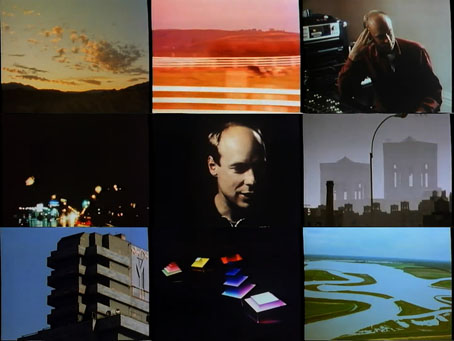The landscapes are those that may come to mind when listening to one of Brian Eno’s instrumentals, as Eno himself explains in this 40-minute portrait by Duncan Ward and Gabriella Cardazzo. I linked to a streaming copy of this several years ago but Flash streams are no use today so it’s good to find again on YouTube. Imaginary Landscapes was made in 1989, and the relatively short running time isn’t really enough to do justice to Eno as either composer or indefatigable theorist. The brevity is also a little surprising when the whole thing was shot on film in the UK, USA and Italy. Maybe expense was an issue? Whatever the answer, we get to see many actual landscapes—California, the rivers and shoreline of Suffolk, the urban landscape of New York City—while Eno explains some of the ideas behind his art and his music. He discusses his time in New York, which he’d recently left to return to his home town of Woodbridge, and his intention to develop his art installations to a greater degree than he’d done in the past. We know now that he did exactly this, I got to see one of his “Quiet Club” installations at the Hayward Gallery’s Sonic Boom group show in 2000. The quietness was rather compromised by sound leakage from other noisier exhibits but it was one of the show’s more memorable pieces.

I’ve a lot of time for Eno’s approach to art installation and the instrumental music he creates for these works, less so for his recent songs. Imaginary Landscapes was made shortly before the release of the song-based Nerve Net, an album I’ve never liked very much, plus another release, The Shutov Assembly, a collection of instrumentals that I’ve listened to more than most of his albums, with the possible exception of Thursday Afternoon. Many of the posts here were written to the accompaniment of The Shutov Assembly, I find it an ideal album of “thinking music”, more so than the later Neroli which is actually titled “thinking music” but which takes the Eno systems approach to a minimal extreme. The Shutov Assembly could be regarded as another collection of imaginary landscapes, with each piece having a nine-letter title that refers to a real location (all of which hosted one of Eno’s artworks) without being in any way illustrative. The Shutov pieces were recorded around the time Imaginary Landscapes was being made, and we see Eno demonstrating synthesizer sounds that are close to some of those you hear on the album. I’d have been happy with a lot more of this, 40 minutes more in fact, but the film-makers had other ideas.
Previously on { feuilleton }
• Harold Budd, 1936–2020
• Synapse: The Electronic Music Magazine, 1976–1979
• Fourth Worlds: A Jon Hassell Mix
• Mistaken Memories Of Medieval Manhattan
• Thursday Afternoon by Brian Eno
• Moonlight in Glory
• Tiger Mountain Strategies
• Generative culture
• My Life in the Bush of Ghosts


I’ve been listening to a lot of ambient music lately so happy to be reminded of The Shutov Assembly. I see an expanded edition was issued. A good excuse to investigate further. A fine companion to Shutov is Eno’s later collaboration with Fripp, The Equatorial Stars. Both works manage to create and sustain wonderful moods. What the Repeat & Shuffle Buttons are for.
One of my current favorites is the original soundtrack to a horror movie released in 2001 called the Mothman Prophecies, produced by the duo Thomas Hajdu and Andy Milburn, who score films under the name Tomandandy. Accompanying the OST is a second disc that contains a collaboration with King Black Acid (Daniel John Riddle) and the American band, Low. I think you could file this one in a folder marked ‘OSTs that are more memorable than the films’.
Yes, I like The Equatorial Stars. As for soundtracks, Eno talks a little about them in the film. Apollo is another one I listen to a great deal although I usually skip Silver Morning. It makes sense in the context of the film but I always feel it spoils the mood of the album.